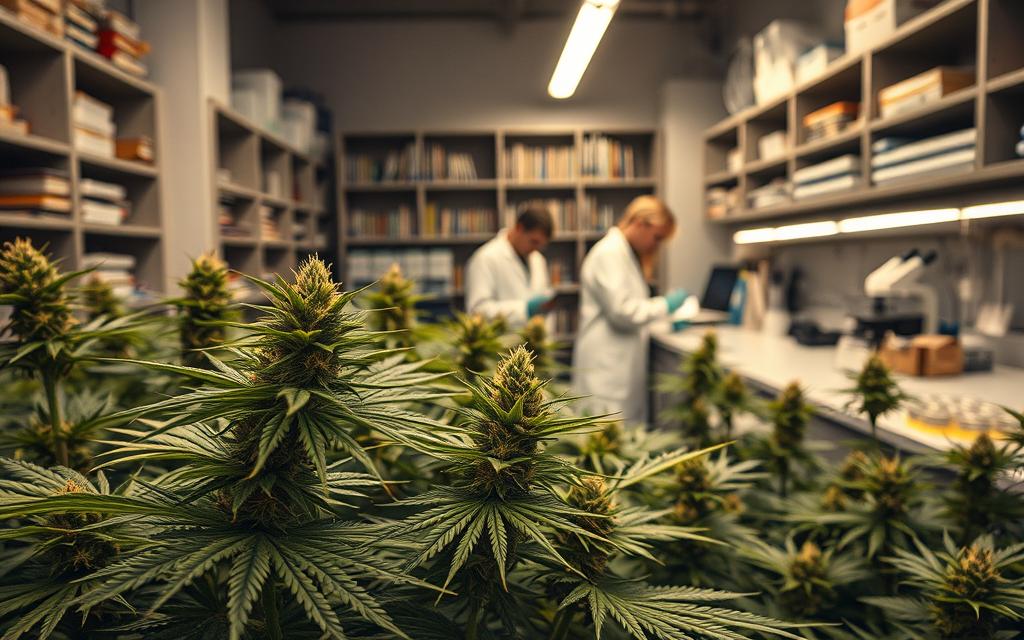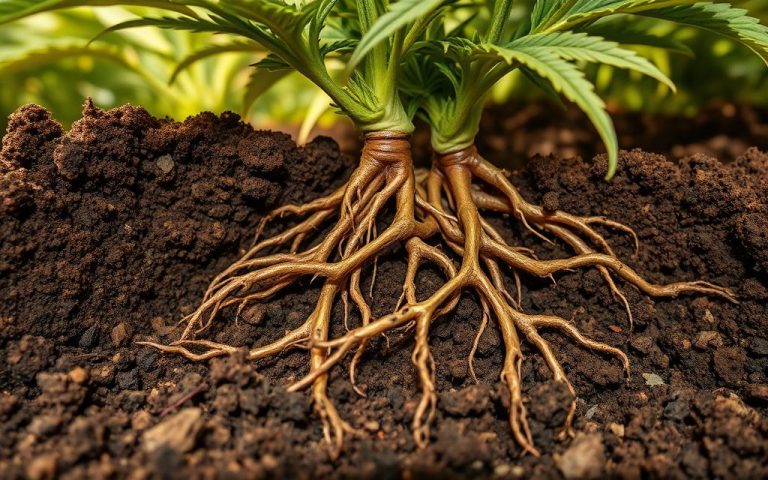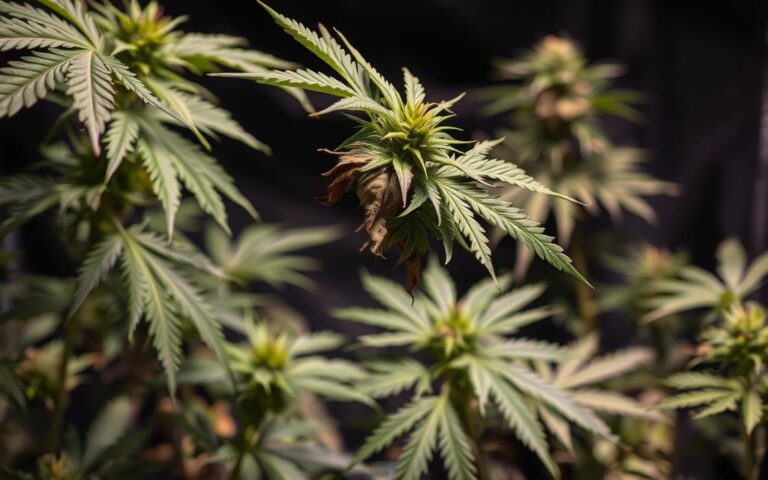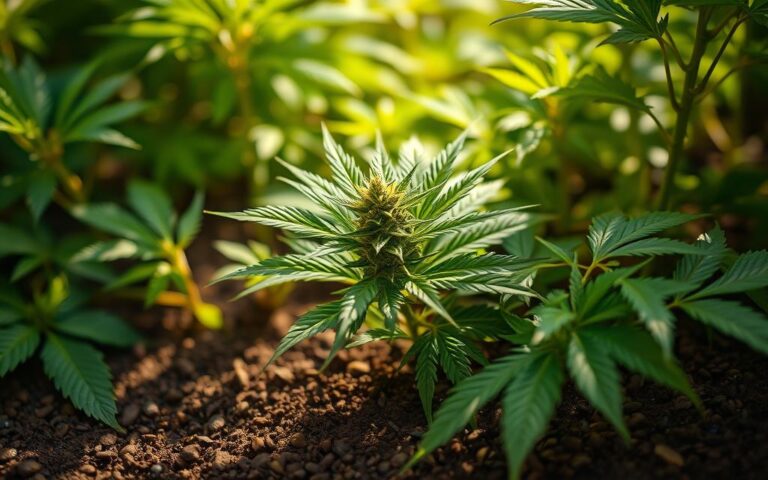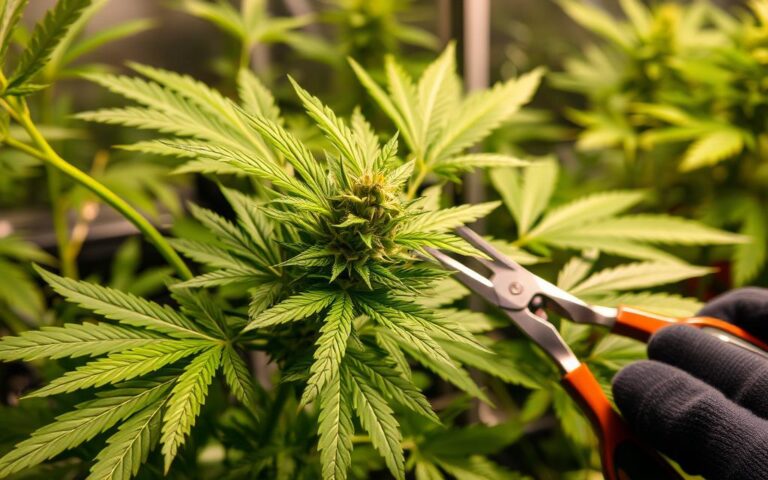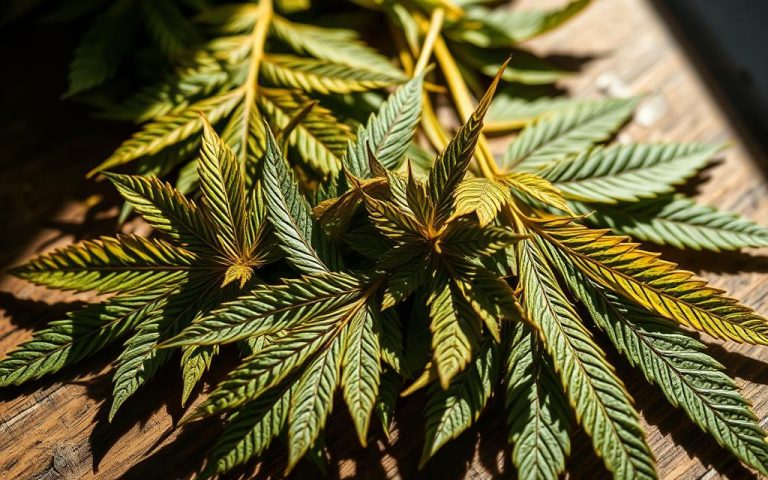How Cannabis Can Support Those with PTSD: A Look into the Research
Post-traumatic stress disorder (PTSD) is a mental health condition affecting 6.8% of U.S. adults. Symptoms like intrusive memories, hyperarousal, and emotional numbness can significantly impact daily life. Traditional treatments, such as SSRIs and psychotherapy, often show limited success, with remission rates hovering around 20-30%.
In recent years, there has been growing interest in alternative therapies. For example, Israel’s medical program has been treating combat veterans with PTSD since 2014, offering relief where conventional methods failed. Additionally, the FDA-approved MJP2 clinical trial is studying high-THC options for veterans with this condition.
This article examines current research on efficacy, safety, and regulatory challenges in treating PTSD. By exploring these factors, we aim to provide a clearer understanding of potential benefits and limitations.
Understanding PTSD and the Potential Role of Cannabis
Living with PTSD can be overwhelming, with symptoms like flashbacks and hyperarousal disrupting daily life. This stress disorder often stems from a traumatic event, such as combat, assault, or natural disasters. According to the DSM-5 criteria, PTSD involves fear-based reexperiencing, avoidance behaviors, and heightened arousal.
Traditional treatments, including SSRIs and psychotherapy, often fall short. Research shows that 46% of patients don’t respond to medications, and 40% drop out of exposure therapy. These limitations have led to the exploration of alternative options, including cannabis use.
Israel’s Ministry of Health has been a pioneer in this area. They mandate cannabis only after two or more failed drug trials and psychotherapy attempts. A study involving chronic combat-PTSD patients showed significant symptom reduction after treatment, offering hope where conventional methods failed.
The endocannabinoid system plays a crucial role in fear extinction and mood regulation. Hill et al.’s study found that PTSD patients have 22% lower levels of 2-AG, a key endocannabinoid. This discovery highlights the potential of targeting this system for effective treatment.
What is PTSD and How Does It Affect Individuals?
PTSD is a disorder that develops after exposure to a traumatic event. Symptoms include intrusive memories, emotional numbness, and hypervigilance. These can severely impact relationships, work, and overall health.
Why Cannabis is Being Explored as a Treatment Option
With limited success from traditional therapies, researchers are turning to cannabis. Its interaction with the endocannabinoid system may address underlying imbalances, offering a new avenue for managing post-traumatic stress.
The Science Behind Cannabis and PTSD
The endocannabinoid system plays a critical role in regulating fear and stress responses, making it a key focus in PTSD research. This system, which includes receptors like CB1, helps modulate anxiety and emotional regulation. When this balance is disrupted, it can contribute to the persistence of PTSD symptoms.
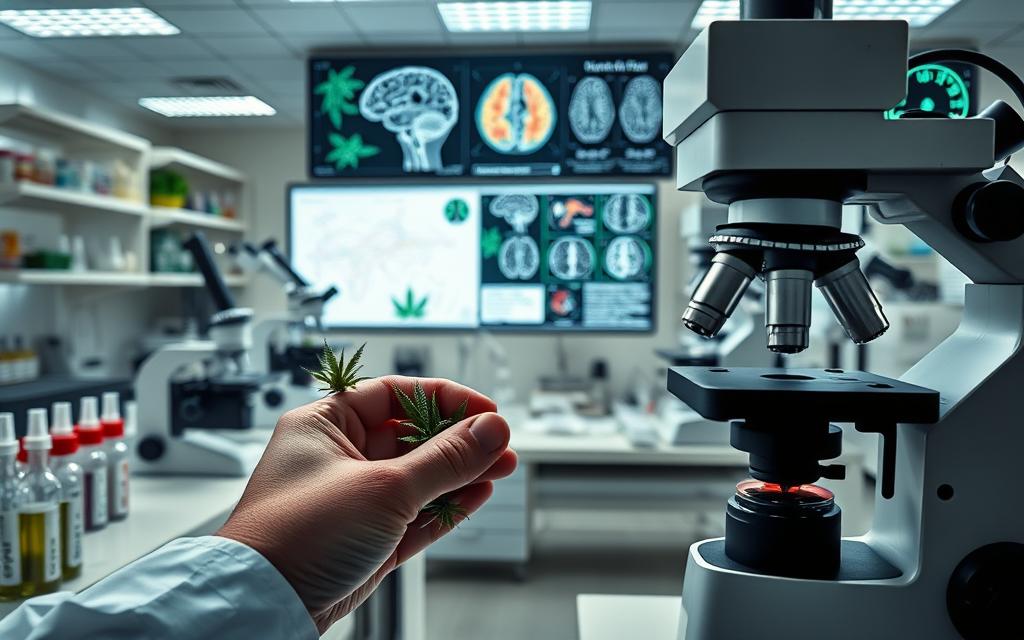
How the Endocannabinoid System Interacts with PTSD
CB1 receptors, found in brain regions like the amygdala and hippocampus, are essential for managing fear responses. Studies show that activating these receptors can reduce anxiety and improve fear extinction. For example, research indicates that individuals with PTSD often have lower levels of 2-AG, a key endocannabinoid, which may explain their heightened stress responses.
According to a study, trauma-focused therapy remains effective even among those using cannabis. This suggests that cannabinoids may complement traditional treatments rather than replace them.
The Effects of THC and CBD on PTSD Symptoms
THC and CBD, two primary cannabinoids, have distinct effects on PTSD symptoms. THC has been shown to improve sleep and fear extinction but may increase anxiety at high doses. In contrast, CBD offers anxiolytic and neuroprotective properties without psychoactive effects.
An Israeli trial involving 14 patients demonstrated a 20% reduction in PTSD symptoms and improved sleep quality after cannabis treatment. However, nightmares showed limited improvement, highlighting the need for further research.
| Cannabinoid | Effects on PTSD Symptoms |
|---|---|
| THC | Improves sleep, enhances fear extinction, may increase anxiety at high doses |
| CBD | Reduces anxiety, provides neuroprotection, non-psychoactive |
These findings underscore the potential of cannabinoids as a therapeutic option for managing PTSD symptoms. However, more research is needed to fully understand their long-term effects and optimal use.
Can Cannabis Help PTSD? Examining the Research
Research into alternative therapies for PTSD has gained momentum, with cannabis emerging as a potential option. While traditional treatments often fall short, recent studies explore its efficacy and safety. This section delves into key findings and limitations in current research.
Key Findings from Clinical Trials and Studies
Only two randomized controlled trials (RCTs) have focused on cannabis for PTSD. One study involving nabilone, a synthetic cannabinoid, showed a 30% reduction in nightmares. Another 3-week trial was underpowered but provided preliminary data on symptom relief.
The MJP2 trial, involving over 300 participants, aims to compare self-titrated high-THC cannabis to a placebo. This large-scale study could offer more robust evidence on its effectiveness. However, the FDA initially paused the trial due to dosage concerns and the inclusion of cannabis-naïve participants. Revised protocols now focus on experienced users.
An Israeli study demonstrated a 20% reduction in symptoms for over 65% of participants. However, it lacked a control group and had a small sample size of 14 patients. Gender differences were noted, with women showing stronger responses, though the sample size for women was limited.
Limitations and Gaps in Current Research
While these studies show promise, significant gaps remain. The Israeli study’s unvalidated PDS translation and lack of a control group limit its reliability. Additionally, the small sample size makes it difficult to generalize findings.
Long-term research is crucial to address potential risks, such as dependence and psychosis. According to a study, more data is needed to understand the effects of prolonged use, especially in vulnerable populations.
Despite these challenges, the exploration of cannabis as a treatment option continues. As research evolves, it may offer new hope for those struggling with PTSD symptoms.
Patient Experiences and Real-World Outcomes
Exploring real-world outcomes offers valuable insights into the effectiveness of alternative therapies for managing trauma-related conditions. Patient experiences, particularly among veterans, highlight the potential benefits of supervised treatment programs. These findings provide a clearer picture of how individuals respond to different approaches.
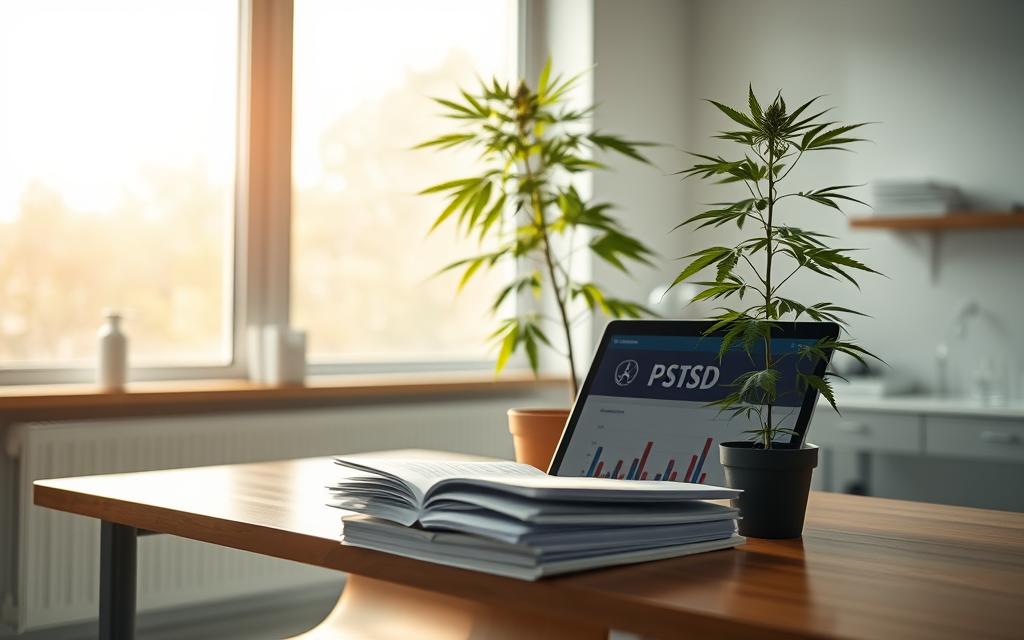
Case Studies: Veterans and Long-Term Cannabis Use
Studies involving veterans reveal promising results. For example, an Israeli cohort of married men with an average of 7.7 years of prior treatment showed significant symptom reduction. Importantly, no cases of addiction were reported during the 1.1-year follow-up period.
Rutgers University’s Project Harmony found that individuals using cannabis achieved comparable reductions in posttraumatic stress symptoms during trauma-focused therapy. This suggests that cannabinoids may complement traditional methods without hindering progress.
Self-Medication vs. Supervised Treatment
While recreational use carries risks, supervised programs demonstrate better outcomes. Research indicates that 22% of recreational users develop cannabis use disorder, compared to 0% in the Israeli study. This highlights the importance of professional guidance in managing trauma-related conditions.
Dr. Sue Sisley’s MJP2 trial underscores this point. Veterans participating in the study reported better relief from supervised cannabis use than from traditional pharmaceuticals. Fixed dosing and pre-bedtime use were key factors in achieving sustained benefits.
| Approach | Outcomes |
|---|---|
| Supervised Treatment | No addiction, sustained symptom reduction |
| Self-Medication | Higher risk of use disorder, variable results |
These findings emphasize the need for structured programs to maximize the therapeutic potential of alternative therapies. As research continues, patient experiences will remain a critical source of insight.
Regulatory Challenges and Future Directions
The regulatory landscape for alternative therapies is evolving rapidly, presenting both opportunities and challenges. As interest in marijuana as a potential treatment grows, regulatory bodies must balance innovation with patient safety. This section explores the current state of approvals, ongoing clinical trials, and the ethical debates surrounding its use.

FDA Approvals and Ongoing Clinical Trials
The FDA has taken a cautious yet progressive approach to evaluating alternative therapies. For instance, the MJP2 trial required five protocol revisions, including additional data on vaporization safety. Michigan’s Veteran Marijuana Research Grant Program has funded this trial to reflect real-world use, emphasizing the importance of practical research.
Despite these efforts, the 2023 ISTSS guidelines still classify marijuana as “experimental” due to insufficient evidence. This highlights the need for more robust studies to establish its safety efficacy.
The Debate Over Marijuana Use in PTSD Therapy
Ethical dilemmas arise when balancing veteran access with the risk of dependence. Organizations like MAPS advocate for real-world dosing, emphasizing the importance of structured programs. Israel’s approach, with a 20g/month limit, contrasts sharply with the variability seen across U.S. states.
Upcoming studies, such as Johns Hopkins’ CBD-focused PTSD trial in 2024, aim to provide clearer insights. These efforts reflect a growing commitment to advancing research and improving patient response to alternative therapies.
Conclusion
Emerging research highlights the potential of alternative therapies in addressing trauma-related conditions. Studies suggest that supervised use may improve sleep and reduce arousal symptoms in resistant cases. However, structured programs are essential to minimize risks like dependence.
Expanding randomized controlled trials, especially with gender-diverse cohorts, could strengthen the evidence base. Regulatory progress, such as the FDA’s approval of the MJP2 trial, signals growing acceptance of these therapies in health care.
Patients are encouraged to consult their providers about adjunctive options after exploring conventional treatments. With continued research, these approaches may offer meaningful benefits for those affected by trauma.

